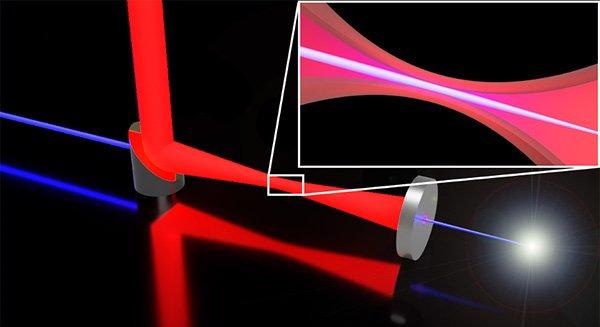Reviewed by Alex SmithApr 12 2022
Researchers often use electron microscopy to visualize microscopic things like viruses, minute structures in semiconductor devices and even atoms arrayed on a material surface. To achieve such great spatial resolution, the electron beam must be focused down to the size of one atom.
 A conceptual illustration of the light-field electron lens. An electron beam (blue) receives the focusing force from a doughnut-shaped light beam (red) at the waist position of the light beam. The inset shows details of the waist area. Image Credit: Yuuki Uesugi et al.
A conceptual illustration of the light-field electron lens. An electron beam (blue) receives the focusing force from a doughnut-shaped light beam (red) at the waist position of the light beam. The inset shows details of the waist area. Image Credit: Yuuki Uesugi et al.
When an electron beam travels through an electrostatic or magnetic lens, the electron rays take on different focal locations depending on the focusing angle, and the beam widens out at the focus. As correcting this “spherical aberration” is expensive and time-consuming, only a few scientists and corporations have atomic-resolution electron microscopes.
Tohoku University researchers have developed a new approach for forming an electron lens that uses a light field rather than the electrostatic and magnetic fields used in traditional electron lenses. The electrons moving in the light field are repulsed from regions of high optical intensity due to a ponderomotive force. A doughnut-shaped light beam positioned coaxially with an electron beam should generate a lensing effect on the electron beam using this phenomenon.
The researchers looked at the properties of a light-field electron lens made from a conventional doughnut-shaped light beam, also known as a Bessel or Laguerre-Gaussian beam, in theory. Researchers were able to quickly establish the guiding parameters required for the actual electron lens design using a simple formula for focal length and spherical aberration coefficients.
The formulae showed that the light-field electron lens produces “negative” spherical aberration, which is the polar opposite of the aberration produced by electrostatic and magnetic electron lenses. The use of a light-field electron lens to balance the aberration and a standard electron lens with a “positive” spherical aberration lowered the size of electron beams to the atomic scale. As a result, the light-field electron lens could be utilized to rectify spherical aberration.
The light-field electron lens has unique characteristics not seen in conventional electrostatic and magnetic electron lenses. The realization of light-based aberration corrector will significantly reduce installation costs for electron microscopes with atomic resolution, leading to their widespread use in diverse scientific and industrial fields.
Yuuki Uesugi, Study Lead Author and Assistant Professor, Institute of Multidisciplinary Research for Advanced Materials, Tohoku University
In the future, Uesugi and colleagues are looking into how the light-field electron lens may be used in next-generation electron microscopes.
Journal Reference:
Uesugi, Y., et al. (2022) Properties of electron lenses produced by ponderomotive potential with Bessel and Laguerre–Gaussian beams. Journal of Optics. doi.org/10.1088/2040-8986/ac6524.